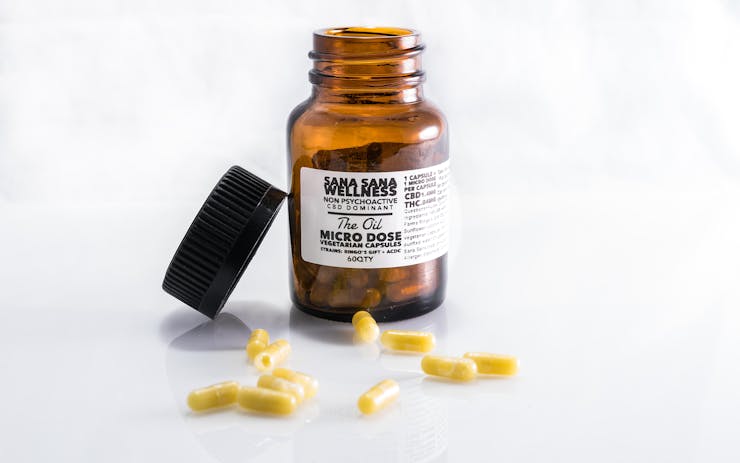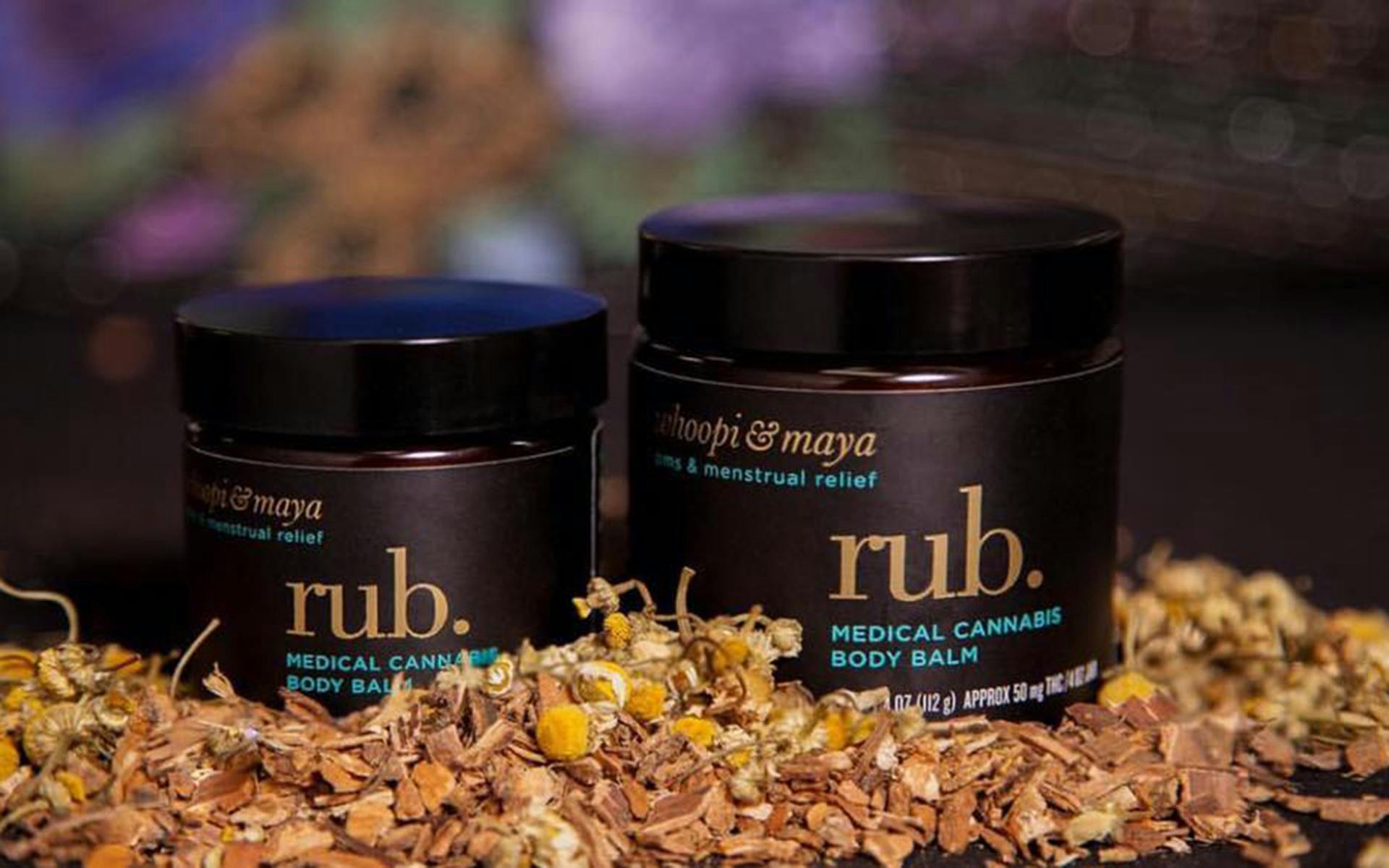In 2014, San Diego native Shannon Barnett, a makeup artist and set nurse now based in Los Angeles, hit a wall with fatigue and a series of red dots and open rashes started to show up everywhere from her ankles to around her mouth. Already dealing with polycystic ovarian syndrome since age 12 and Raynaud’s disease since in 2009, Barnett was prescribed hormones, steroids, and even anti-malaria medicine to help fight the painful symptoms.
Nothing was working. The medicines triggered lupus, Sjögren’s syndrome, and other bad side effects, including dry mouth from the absence of saliva, which caused her teeth and gums to deteriorate at a fast rate. She visited a top rheumatologist associated with John Hopkins and was told there’s no cure, but she could take Plaquenil and Prednisone. Barnett questioned him and asked herself, why bother if there’s no cure and she continuously experiences bad side effects?
“I asked for a product that wouldn’t get me high–the budtenders were just like, ‘What?'”
Barnett was sick of her bank account depleting doctor visit after dentist visit with no results, even with her clean, healthy diet. She took matters into her own hands and began research online. CBD came up over and over in related searches on inflammation and autoimmune diseases. Barnett was never a recreational cannabis consumer, but decided to try it after enough research.
‘Breaking Good’

(Courtesy of Shannon Barnett)
After getting her medical cannabis authorization, Barnett went to a dispensary to find some CBD products. “It was not that great. They were smoking inside, and when I asked for something [high in] CBD that didn’t have THC in it–something that wouldn’t get me high–they were just like, ‘What?’”
Small doses of cannabis could deliver better results in some patients, despite the fact that this seems contradictory to the way most medicine is approached.
As a nurse, she was looking for the gold standard amongst products, but soon discovered that the market was far from that. She found tinctures made with ACDC, a CBD-dominant strain, but they were all made with alcohol, which burned her mouth since she was suffering from such bad dry mouth symptoms.
Barnett visited another dispensary in West Hollywood and found a coconut oil THC tincture. Despite the lack of information available about the product, she decided to buy it and use it topically since she couldn’t ingest the THC. Lo and behold, it cleared her rash.
She returned for more, but the product looked different this time–the color gradient had changed. Barnett tried to explain to the budtender something was off about the product, but there was no explanation until she later spoke with a friend’s father, who was a long-time home grower.
“He told me, they’re fucking with science,” Barnett said. “They’re just trying to get a product made; they weren’t even making it to a standard.”
Her friend’s father gifted her an organic OG strain. “I couldn’t ingest what he gave me, but I was making something to use topically,” Barnett said. “This is when everyone said I was ‘breaking good.’”
The CBD Microdose Experiment
It started to work, but Barnett was still not totally better. A bad car accident caused a stress rash all over her face, and when the settlement came in 2016, she decided to find a good source to make her own ingestible CBD-dominant products.
While researching potency and dosing, Barnett came across an article about microdosing that changed everything. She learned that very small doses of cannabis could deliver better results in some patients, despite the fact that this seems contradictory to the way most medicine is approached. “If you tell a doctor that [a medication] is not working, they say take more,” she said.
On November 14, 2016, Barnett woke up to the sound of her alarm at 5:00 a.m. Typically, her symptoms would keep her up through the night, and fatigue would keep her down through the alarm’s call. But this morning was different. She put two microdoses of oil under her tongue, and within fifteen minutes, she’d fallen asleep. When her alarm went off at dawn, she woke up–feeling refreshed. “I was like, ‘no way,'” Barnett said. “No way, this isn’t even possible.”
Since then, Barnett’s health has returned alongside clarity in her skin. Inspired by the improvement in her own life, she has since invested in sharing her healing with others, and endeavor she today calls Sana Sana Wellness.
Then Came Sana Sana Wellness

(Courtesy of Sana Sana Wellness)
Based in California, Sana Sana Wellness is a medicinal product line that provides CBD-rich whole flower medicine, sourced from CBD-dominant strains from top-quality farms.
In Barnett’s exploratory phase, she tried many hemp-derived CBD products, but never had success. She found that CBD from other cannabis varieties provided a wider therapeutic window at lower doses–that lower, broader dosage range could activate the endocannabinoid receptors while encouraging the consumer to be mindful of how the medicine is working.
Transparency is vital to Barnett, and she provides a free consultation for every patient who purchases her products. Many who use her oil topically for chemo skin relief, scars, and wounds from accidents send photos often to share their results.
Her first product was “The Oil,” an ingestible/topical CBD-infused coconut oil sourced from the strains Ringo’s Gift (sun-grown by Ninja Dirt Farms) and ACDC.
Everything is organic, though there is no regulation in place to allow her to legally say so. Barnett’s suggested serving size is 0.25 gram, which contains 1.4 mg of CBD and 0.4 mg of THC. It can be purchased as an oil or capsule.
There’s also the Black Label, an oil sourced from Ringo’s Gift and Granddaddy Purple (1.5mg of CBD and 0.5mg of THC per serving), as well as CBD Plus (18.9mg CBD and 1.1mg THC).
Sharing the Knowledge
Knowledge is central to Barnett’s mission of providing only the safest, most effective methods for consuming cannabis. “If I can help you better understand how to use it for yourself, that’s a win for both of us, right?” she said. Out of the research rabbit hole finally, she stocked the Sana Sana Wellness website with a library of vetted, unbiased information so others could educate themselves.
“You don’t need to accept vague answers just because you assume that's the norm in cannabis.”
“I wanted people to know what they should be able to ask,” she said. “You don’t need to accept vague answers just because you assume that’s the norm in cannabis.”
Her product line expanded to include a Manuka honey facial scrub, a bath bomb, and even suppositories after hearing one customer’s success story in treating a hemorrhagic right ovary with The Oil. She had told her doctor about the CBD oil, and he immediately called Barnett to learn more.
Patient-doctor communication is integral to Sana Sana Wellness. “As much as I think you shouldn’t take what one doctor is telling you as the law, you should always consult with your primary care physician,” she said. “They should be a part of this. Accessibility and transparency open their minds.”
Sana Sana takes its name from the humorous Latino folk song, which tells, “Sana, sana, colita de rana, si no sana hoy, sanará mañana, si no sana hoy, sanará mañana,” which translates to:
“Heal, heal, little frog tail, if it doesn’t heal today, it’ll heal tomorrow.”






